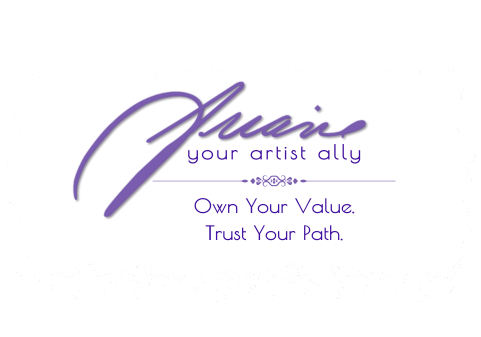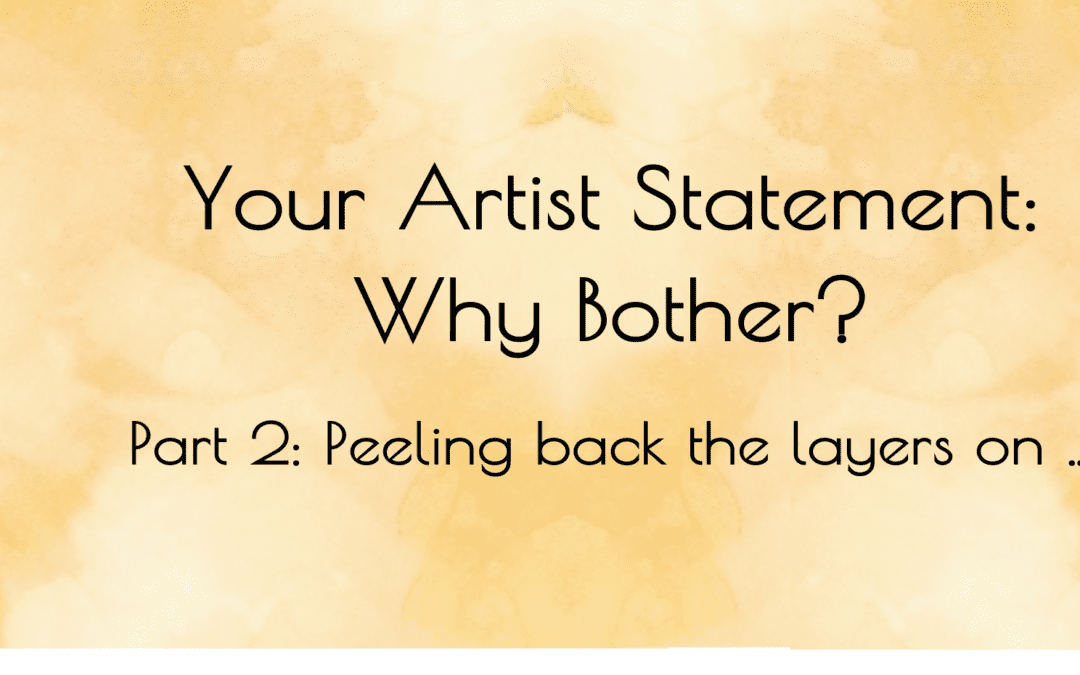
HOW TO RELISH YOUR ARTIST STATEMENT
Here’s two things I know to be true about artist statements:
- An immediate, very human desire arises when someone is moved by your art: to know more about the person who moved them. Simple. Undeniable.
- At the outset, an artist statement may be used for art patrons, gallery owners, websites, applications (grants/residencies, etc.), press releases, etc., but more than that, it’s also for you, the artist. Here’s an Artist Statement Stress Test: A True Story
I suggested to one of my private clients that he display an “art” statement beside each of his sculptures for an major exhibition.
Wait… let’s back up. What’s an Art Statement?
An Art Statement is an artist statement tailored to an individual piece of art. Instead of a succinct, overview of your artistic vision, the Art Statement sticks to a single piece.
Now, Back To Our Artist Statement Story…
Before his solo, sculpture exhibit, he and I talked at length about presentation strategies.
If you’re going to the trouble of writing a statement, then making sure it’s easy to access and read just makes sense.
I was pleased, when I attended the exhibit, with how he’d mounted each typed “art statement,” on handmade paper, at the top of a thin, metal pole set in a simple disc on the floor.
Those typed statements were assembled at the perfect height. A viewer could walk right up and read it. And, even if someone else was peering over the first person’s shoulder, the font size and word placement allowed that second, or even third, person to read it too.
His presentation followed all the best practices I’d put together. But what I observed, as over 200 guests mingled in and around his pieces, truly astounded me.
Written Artist Statements Are Innately Compelling.
The caveat: when presented well!
I make this claim because of my first-hand experience during a long evening of quiet observation.
As I too mingled with the guests this happened: whenever someone approached a sculpture, they would glance at his piece, then immediately turn their head to read his art statement for that piece.
After reading, they would turn back to look at the piece with an appreciative nod or smile. These weren’t cursory observations. They would lean in and study the sculpture, walk around it, talk about it, then walk around it some more.
Once in a while, they would return to the art statement again. Then back to the sculpture.
You could almost see, on their faces, how their brains were connecting with what they saw (visual language) with what they read (word language).
And this happened over and over and over again… confirming what I’ve suspected all along…
The Heart of an Artist Statement Embraces a Deep Truth…
When your statement is effective and presented with care, that statement creates an engaging, meaningful connection to your artwork because it ignites our human thirst for story.

And that’s not all it does.
Once you fan the flames of an engaging story, that goes on to trigger someone’s long-term memory.
Connecting your visual language with word language builds neural connections in the viewer’s brain about you and your work, because it immerses the viewer in not just one, but two languages: visual and linguistic.
As the viewers read those art statements that night, and then looked more closely at the sculptures, they also began a conversation with the people near them about the connections they were seeing between what they read and what they saw.
Between these two, different forms of creative expression.
This highlights some of the brain research in science communications that shows how thinking about a narrative, and talking to others, reinforces our memory and, over time, can drive a broader change in attitudes—quite literally changing aspects of our world.
In an interview with Liz Neeley, a scientist working in science communications, the host of NPR’s Short Wave podcast, Maddie Sofia, gave Neeley the opportunity to make two points:
- Word narratives are so powerful they can “shift stereotypes” about who we are.
- Research data suggests that people remember things better, and are more engaged by stories, over a list of facts, like a resume or artist bio.

Imagine the implications of these two points for the people in your world who love your work.
An Artist Statement can, subtly, alter some of the artist myths and stereotypes floating around. And simultaneously, help you and your work stay longer in your viewers’ brains.
Why would any rational artist give up learning to wield this kind of power?
It’s a question that haunts my sleep.
Artist Statements: What’s Good for the Viewer is Even Better For the Artist.
Writing an artist statement is not easy.
Oh, I know, all kinds of artist advocates might use the “5 Easy Steps to Writing Your Artist Statement” to persuade you otherwise.
And, if you’re a surface-level kind of artist, who doesn’t enjoy digging into their psyche for hidden material, I suppose you could write an artist statement that would hit all the surface benchmarks.
What a surface-level artist statement can never do is give you the kind of insight into your own artistic process that signals to your viewer, “Ah, now this is fascinating. This is compelling…”
At best, it passes English 101. At worst, it comes off trite, inauthentic, and padded with generalizations.
Once you’ve decided to use writing your artist statement as a way to deepen, enrich, and expand your relationship to your artistic process, you’ll find the exercise gives you a surprising and new way to reflect upon your work.
It’s not at all unusual, when I’m working with a private client, to get some variation of what my most recent client, a mid-career professional artist, said to me:
I didn’t think I would have anything to say but there are all these words and phrases and sentences coming out now…L.A.
And that was followed by pages of material she’s uncovered, all waiting inside her psyche for permission to show up.
It Takes Courage to go Into the Heart of Your Artistic Process…
… and bring the intuitive into consciousness.
The magic happens when you search for words that truly reflect your relationship to your art, and experience an upsurge in your creative flow.
Surprising benefits show up whenever we tackle a form of self-expression that pushes us out of our comfort zone. Like sweat from physical exertion, the very struggle gets our juices flowing.
One of the great keys to creativity is to work against the grain, get out of familiar mindsets, and shake things up. And for artists, whose very practice is founded on being unique, it can be hard to recognize when a pattern has become familiar.
For prospective art buyers, your artist statement will draw them closer to your work. For you, the artist, writing your artist statement gives you an opportunity to deepen your own awareness.
I mean, what’s not to love?
Writing my artist statement gave me a chance to focus on myself. It opened up more creative juice and self-expression than I had experienced in a long time. Taming my internal critic, and the roadblocks to my inner mind, gave me new skills to express my heartfelt emotions to others.
Working on my statement gave me the opportunity to delve into my inner soul and reflect on the science of “me.” When I took the time to evaluate what, how and why I do what I do, it refined my work and gave me a fresh, determined self-confidence that I had lacked before.
~ Norbert Ohnmacht, sculptor
*****
Nine Reasons to Banish Resistance & Relish Your Artist Statement
For The Artist:
Writing an artist statement asks you to, once and for all, recognize the faces of your true self: Truth. Power. Beauty.
- You may feel the relationship you have with your work is already pretty strong. But once you write your artist statement, I promise you’ll lift way above your level.
- Writing an artist statement affirms what you do, and so, by extension, also affirms you. And who would give up being affirmed?
- Self-trust can be hard to come by. Writing your artist statement makes another statement about you: that you trust yourself enough to flow into another realm of creative expression.
- Writing your artist statement invites you to experience an expanded awareness about yourself and your art. Given a chance to update your own art experience, why wouldn’t you?
- Writing your artist statement is a rare and precious time to engage your artistic soul.
Digging deep into the artist statement reveals more about your work than even you suspected. Surprise yourself!

For The Viewer, Your Potential Buyer:
- Your artist statement builds a compelling bridge between your viewer and your work. Of course your art is the real deal. But when connecting to your potential buyers on more than one level increases their interest, and thus the likelihood of a sale, why wouldn’t you?
- Your artist statement enriches the connection between the artist, the art, and the art patron, and influences how long the memory or your work stays in your viewer’s long-term storage.
- Because it is a powerful experience for your viewers when you use the tool of language to support the art you love giving to the world.
Drop a line in the blog post comments below.
I’d love to know what stage you’re in of the writing-your-artist-statement process.
Do tell!

Whenever you’re ready to update your artist statement, or even write your first one, join my waitlist for: Writing The Artist Statement eBook & Ambitious Bundle.
It’s not enough to know what an artist statement is. You need to know how to write one!
This new 3rd edition eBook with its Ambitious Bundle takes you from head scratching to a polished, compelling artist statement. Check it out!



